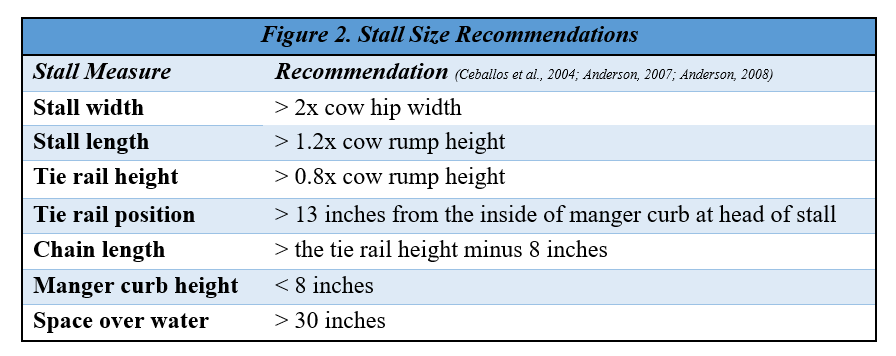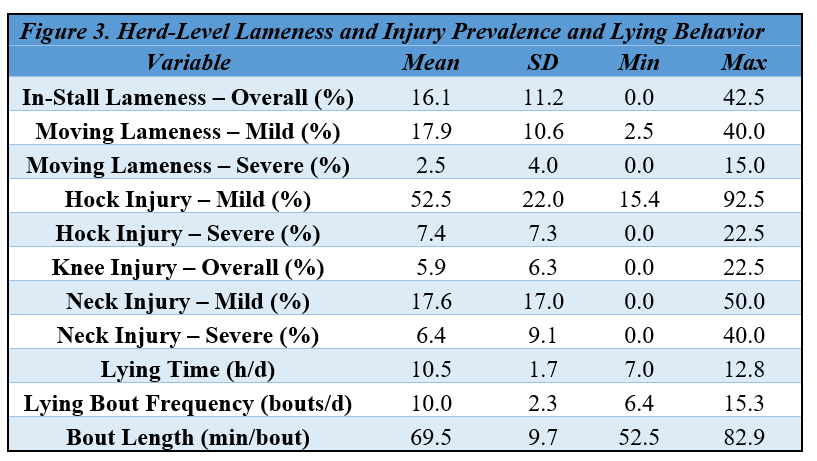By Lindsay Ferlito and Betsy Hicks (CCE South Central NY Dairy and Field Crops Team)
Several studies have been completed in the US looking at freestall cow comfort, but very little work has been done focusing on lameness, injuries, and lying behavior on tiestall dairies in New York. With about 25% of the dairy cattle in the US, and lameness being one of the costlier issues impacting dairies, a recent Cornell Cooperative Extension research project aimed to fill this gap and provide farmers with valuable farm-specific data.
Dairy Specialists from the North Country Regional Ag Team and the South Central NY Dairy and Field Crops Team secured two rounds of funding from the New York Farm Viability Institute. A total of 22 tiestall dairies (11 in Northern NY and 11 in South Central NY) were enrolled, and data was collected during the summer of 2017 and the summer of 2018. Each herd was visited at least twice to collect the management and facilities data and the animal-based measures. On each farm, 8-9 random stalls throughout the barn were assessed for stall dimensions, bedding amount, and bedding cleanliness. Forty random cows were assessed on each farm for injuries (hock, knee, and neck), lameness, BCS, hygiene, and lying behavior. After the on-farm assessment, each farm received a report highlighting their summarized data, how they compared to the benchmark of the 22 participating farms, and some strengths and areas of opportunity were identified. After 6-12 months, dairies were visited again, and if there were any management or facility changes, a reassessment was completed, and improvements were documented.
Overall, most dairies had stalls that were too small based on their cow size. Only 4 of the 22 herds met the requirements for stall length, 11 dairies met the requirement for stall width, and only 2 had a tall enough tie rail (Figure 1 and Figure 2).
Overall, there were large differences from herd to herd in lameness, injury prevalence, and lying behavior (Figure 3).
In most cases, farms that did not meet stall recommendations on a certain dimension or practice commonly had injuries correlating to that stall recommendation. For instance, herds that had too aggressive of a tie rail often had a high prevalence of neck injuries. Herds that used less bedding often times had higher rates of hock injuries.
Even though most dairies did not meet recommendations for stall size, the farm’s management of stalls and cows often was able to overcome, or at least counteract, the pitfalls of poor stall design. Some farms that lacked a soft mattress added more bedding to stalls to help cushion the surface, or lengthened the tie chain to give cows more freedom of movement while tied. Others utilize an exercise yard or pasture daily so that cows can move about, minimizing joint stiffness and helping mobility.
Perhaps the most interesting data that herds received was related to lying behavior on their farm. Some herds had already retrofitted a portion of their barn, and wanted to compare lying times to original stalls. Some herds wanted to compare pasture lying times with winter (barn) lying times. Others even used the data to determine that one end of the barn was more comfortable than another and made changes accordingly.
In all, properly sized stalls and good management of cows and stalls are pillars of cow comfort. Increasing cow comfort increases productivity of the herd, and can increase a cow’s longevity in the herd. All of these things positively impact profitability of the dairy. A whole-system approach to cow comfort will bring about the most impactful changes: increasing management skills, access to pasture, focusing on heat abatement, and stall renovations will all help cow comfort. There is no “cookie-cutter” solution. Changes can be extensive or low-cost; both will help a dairy achieve their goals of improved cow comfort and profitability.
Check out the video below for more information on the project and to hear from participating farmers.



